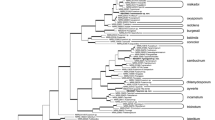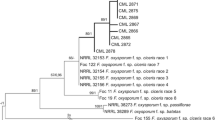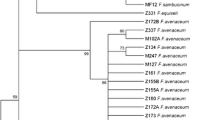Abstract
Fusarium isolates were obtained from asymptomatic seeds of wild grasses collected in six regions of Brazil. Eleven phylogenetic species were identified among 41 isolates based on sequences of EF-1α. These are members of the F. fujikuroi (FFSC, n = 24), F. incarnatum-equiseti (FIESC, n = 13), and F. chlamydosporum (FCSC, n = 5) species complexes that encompass known plant pathogens, mycotoxigenic species, and endophytes. Phylogenetic analyses based on EF-1α, RPB2, and TUB revealed two new species, F. caapi and F. brachiariae, that belong to the African clade of the FFSC and share main morphological features of F. mundagurra and F. nygamai. Another encountered isolate formed a singleton phylogenetic lineage within the FIESC. This survey shows that naturally occurring and cultivated grasses not only harbor a high diversity of known species, which are pathogens of maize, sorghum, rice, and sugarcane, but also novel Fusarium species.





Similar content being viewed by others
Data availability
Biological reference material is deposited and available in official collections and DNA sequences and alignments at GenBank and TreeBASE, respectively.
References
Bentley AR, Petrovic T, Griffiths SP, Burgess LW, Summerell BA (2007) Crop pathogens and other Fusarium species associated with Austrostipa aristiglumis. Australasian Plant Pathol 36:434–438
Borghi E, Crusciol CAC, Mateus GP, Nascente AS, Martins PO (2013a) Intercropping time of corn and palisadegrass or guineagrass affection grain yield and forage production. Crop Sci 53:629–636
Borghi E, Crusciol CAC, Nascente AS, Sousa VV, Martins PO, Mateus GP, Costa C (2013b) Sorghum grain yield, forage biomass production and revenue as affected by intercropping time. Eur J Agron 51:130–139
Botha CJ, Truter M, Jacobs A (2014)Fusarium species isolated from Pennisetum clandestinum collected during outbreaks of kikuyu poisoning in cattle in South Africa: research communication. Onderstepoort J Vet Res 81:1–8
Burgess LW, Trimboli D (1986) Characterization and distribution of Fusarium nygamai, sp. nov. Mycologia 78:223–229
Carter LLA, Leslie JF, Webster RK (2008) Population structure of Fusarium fujikuroi from California rice and water grass. Phytopathology 98:992–998
Chehri K, Hajeb S, Maassoumi SM (2017) Morphological and molecular identification and PCR amplification to determine the toxigenic potential of Fusarium graminearum species complex (FGSC) isolated from wild grasses in Iran. J Agric Sci Technol 19:1617–1629
Costa MM, Melo MP, Guimarães EA, Veiga CMO, Costa SS, Sandin FC, Moreira GM, Pfenning LH (2019) Identification and pathogenicity of Fusarium species associated with pokkah boeng of sugarcane in Brazil. Plant Path 68:1350–1360
Darriba D, Taboada GL, Doallo R, Posada D (2012) jModelTest 2: more models, new heuristics and parallel computing. Nat Methods 9:772
Duncan KE, Howard RJ (2010) Biology of maize kernel infection by Fusarium verticillioides. Mol Plant-Microbe Interact 23:6–16
Elmer WH, Robert E, Marra RE, Li H, Li B (2016) Incidence of Fusarium spp. on the invasive Spartina alterniflora on Chongming Island, Shanghai, China. Biol Invasions 18:2221–2227
Ezekiel CN, Kraak B, Sandoval-Denis M, Sulyok M, Oyedele OA, Ayeni KI, Makinde OM, Akinyemi OM, Krska R, Crous PW, Houbraken J (2020) Diversity and toxigenicity of fungi and description of Fusarium madaense sp. nov. from cereals, legumes and soils in north-central Nigeria. MycoKeys 67:95–124
Hepperle D (2004) SeqAssem©. Win32–version. A sequence analysis tool contig assembler and trace data visualization tool for molecular sequences. Available at: http://www.sequentix.de
Kago L, Njuguna J, Njarui DMG, Ghimire SR (2016) Fungal endophyte communities of Brachiaria grass (Brachiaria spp.) in Kenya. In: Njarui DMG, Gichangi EM, Ghimire SR, Muinga RW. (eds). Climate smart Brachiaria grasses for improving livestock production in East Africa – Kenya experience. Proceedings of the workshop held in Naivasha, Kenya, 14–15 September. Nairobi, Kenya. 271 p
Klittich CJR, Leslie JF (1988) Nitrate reduction mutants of Fusarium moniliforme (Gibberella fujikuroi). Genetics 118:417–423
Kumar S, Stecher G, Li M, Knyaz C, Tamura K (2018) MEGA X: molecular evolutionary genetics analysis across computing platforms. Mol Biol Evol 35:1547–1549
Kvas M, Marasas WFO, Wingfield BD, Wingfield MJ, Steenkamp ET (2009) Diversity and evolution of Fusarium species in the Gibberella fujikuroi complex. Fungal Divers 34:1–21
Laurence MH, Walsh JL, Shuttleworth LA, Robinson DM, Johansen RM, Petrovic T, Vu TTH, Burgess LW, Summerell BA, Liew ECY (2016) Six novel species of Fusarium from natural ecosystems in Australia. Fungal Divers 77:349–366
Leslie JF, Summerell BA (2006) The Fusarium laboratory manual. Blackwell, Sydney 388p
Leslie JF, Zeller KA, Logrieco A, Mulè G, Moretti A, Ritiene A (2004) Species diversity of and toxin production by Gibberella fujikuroi species complex strains isolated from native prairie grasses in Kansas. Appl Environ Microbiol 70:2254–2262
Leslie JF, Zeller KA, Lamprecht SC, Rheeder JP, Marasas WFO (2005) Toxicity, pathogenicity, and genetic differentiation of five species of Fusarium from sorghum and millet. Phytopathology 95:275–283
Liu YJ, Whelen S, Hall BD (1999) Phylogenetic relationships among ascomycetes: evidence from an RNA polymerase II subunit. Mol Biol Evol 16:1799–1808
Mallmann G, Verzignassi JR, Fernandes CD, Santos JM, Vechiato MH, Inácio CA, Batista MV, Queiroz CA (2013) Fungos e nematoides associados a sementes de forrageiras tropicais. Summa Phytopathol 39:201–203
Moreira GM, Nicolli CP, Gomes LB, Ogoshi C, Scheuermann KK, Silva-Lobo VL, Schurt DA, Ritieni A, Moretti A, Pfenning LH, Del Ponte EM (2020) Nationwide survey reveals high diversity of Fusarium species and related mycotoxins in Brazilian rice: 2014 and 2015 harvests. Food Control 113:107171
Moretti ML, Busso-Lopes AF, Tararam CA, Moraes R, Muraosa Y, Mikami Y, Gonoi T, Taguchi H, Lyra L, Reichert-Lima F, Trabasso P, Hoog GS, Al-Hatmi AMS, Schreiber AZ, Kamei K (2018) Airborne transmission of invasive fusariosis in patients with hematologic malignancies. PLoS One 13:e0196426
Nicolli CP, Haidukowski M, Susca A, Gomes LB, Logrieco AF, Stea G, Del Ponte EM, Moretti A, Pfenning LH (2020)Fusarium fujikuroi species complex in Brazilian rice: unveiling increased phylogenetic diversity and toxigenic potential. Int J Food Microbiol 330:108667
Nor Azliza IN, Hafizi R, Nurhazrati M, Salleh B (2014) Production of major mycotoxins by Fusarium species isolated from wild grasses in peninsular Malaysia. Sains Malaysiana 43:89–94
O’Donnell K, Cigelnik E (1997) Two divergent intragenomic rDNA ITS2 types within a monophyletic lineage of the fungus Fusarium are nonorthologous. Mol Phylogenet Evol 7:103–116
O’Donnell K, Cigelnik E, Nirenberg HI (1998) Molecular systematics and phylogeography of the Gibberella fujikuroi species complex. Mycologia 90:465–493
O’Donnell K, Sutton DA, Fothergill A, McCarthy D, Rinaldi MG, Brandt ME, Zhang N, Geiser DM (2008) Molecular phylogenetic diversity, multilocus haplotype nomenclature, and in vitro antifungal resistance within the Fusarium solani species complex. J Clin Microbiol 46:2477–2490
O’Donnell K, Rooney AP, Proctor RH, Brown DW, McCormick SP, Ward TJ, Frandsen RJ, Lysoe E, Rehner SA, Aoki T, Robert VA, Crous PW, Groenewald JZ, Kang S, Geiser DM (2013) Phylogenetic analyses of RPB1 and RPB2 support a middle Cretaceous origin for a clade comprising all agriculturally and medically important fusaria. Fung Gen Biol 52:20–31
O’Donnell K, McCormick SP, Busman M, Proctor RH, Ward TJ, Doehring G, Geiser DM, Alberts JF, Rheeder JP (2018) Marasas et al. 1984 “Toxigenic Fusarium species: identity and mycotoxicology” revisited. Mycologia 110:1058–1080
Oldenburg E, Ellner F (2015) Distribution of disease symptoms and mycotoxins in maize ears infected by Fusarium culmorum and Fusarium graminearum. Mycotoxin Res 31:117–126
Petrovic T, Burgess LW, Cowie I, Warren RA, Harvey PR (2013) Diversity and fertility of Fusarium sacchari from wild rice (Oryza australiensis) in northern Australia, and pathogenicity tests witch wild rice, rice, sorghum and maize. Eur J Plant Pathol 136:773–788
Pfenning LH, Melo MP, Costa MM, Reis A, Cabral CS, Lima CS, Abreu LM, Costa SS (2019)Fusarium udum revisited: a common, but poorly understood member of the Fusarium fujikuroi species complex. Mycol Prog 18:107–117
Phan HT, Burgess LW, Summerell BA, Bullock S, Liew EC, Smith-White JL, Clarkson JR (2004) Gibberella gaditjirrii (Fusarium gaditjirrii) sp. nov., a new species from tropical grasses in Australia. Stud Mycol 50:261–272
Pili NN, França SC, Kyndt T, Makumba BA, Skilton R, Höfte M, Mibey RK, Gheysen G (2016) Analysis of fungal endophytes associated with rice roots from irrigated and upland ecosystems in Kenya. Plant Soil 405:371–380
Proctor RH, Van Hove F, Susca A, Stea G, Busman M, Lee T, Ward TJ (2013) Birth, death and horizontal transfer of the fumonisin biosynthetic gene cluster during the evolutionary diversification of Fusarium. Mol Microbiol 90:290–306
Ronquist F, Teslenko M, Van Der Mark P, Ayres DL, Darling A, Höhna S, Larget B, Liu L, Suchard MA, Huelsenbeck JP (2012) MrBayes 3.2: efficient Bayesian phylogenetic inference and model choice across a large model space. Syst Biol 61:539–542
Steenkamp ET, Wingfield BD, Coutinho TA, Zeller KA, Wingfield MJ, Marasas WFO, Leslie JF (2000)PCR–based identification of MAT–1 and MAT–2 in the Gibberella fujikuroi species complex. Appl Environ Microbiol 66:4378–4382
Sung GH, Sung JM, Hywel-Jones NL, Spatafora JW (2007) A multi-gene phylogeny of Clavicipitaceae (Ascomycota, Fungi): identification of localized incongruence using a combinational bootstrap approach. Mol Phylogen Evol 44:1204–1223
Teasdale SE, Caradus JR, Johnson LJ (2018) Fungal endophyte diversity from tropical forage grass Brachiaria. Plant Ecol Div 11:611–624
Timossi PC, Durigan JC, Leite GJ (2007) Formação de palhada por braquiárias para adoção do sistema plantio direto. Bragantia 66:617–622
Villani A, Moretti A, Saeger SD, Han Z, Mavungu JDD, Soares CMG, Proctor RH, Venâncio A, Lima N, Stea G, Paciolla C, Logrieco AF, Susca A (2016) A polyphasic approach for characterization of a collection of cereal isolates of the Fusarium incarnatum-equiseti species complex. Int J Food Microbiol 234:24–35
Walsh JL, Laurence MH, Liew ECY, Sagalang AE, Burgess LW, Summerell BA, Petrovic T (2010)Fusarium: two endophytic novel species from tropical grasses of northern Australia. Fungal Divers 44:149–159
Zeller KA, Summerell BA, Bullock S, Leslie JF (2003)Gibberella konza (Fusarium konzum) sp. nov. from prairie grasses, a new species in the Gibberella fujikuroi species complex. Mycologia 95:943–954
Acknowledgments
Thanks are due to Edson Luis Rezende for the technical assistance.
Funding
Part of this research was supported by Conselho Nacional de Desenvolvimento Científico e Tecnológico - CNPq (Proc. 406335/2013-5). The first and second authors acknowledge a fellowship given by CNPq (Proc. 140818/2020-0 and Proc. 156738/2011-2). LHP acknowledges a grant given by CNPq (Proc. 311888/20178).
Author information
Authors and Affiliations
Contributions
Marileide M. Costa and Ludwig H. Pfenning designed the project, supervised its execution, wrote the first draft of the manuscript, and prepared the taxonomic descriptions. Maruzanete P. Melo, Filipe S. Carmo, Elaine A. Guimarães, and Fernando S. Rocha contributed with collection of material, isolation, identification, and preservation of fungal species and the elaboration of the discussion. Gláucia M. Moreira, Sarah S. Costa, and Lucas M. Abreu contributed with sequence analysis, preparation of phylogenetic trees, and overall analysis of the data. All authors commented on previous versions of the manuscript and approved the final version. Therefore, they had full access to all the data obtained in this study and take responsibility for the integrity and security of the data.
Corresponding author
Ethics declarations
Conflict of interest
The authors declare that they have no conflicts of interest.
Ethics approval
Not applicable.
Consent to participate
Not applicable.
Consent for publication
Not applicable.
Code availability
Not applicable.
Additional information
Editorial Responsibility: Hans-Josef Schroers
Publisher’s note
Springer Nature remains neutral with regard to jurisdictional claims in published maps and institutional affiliations.
Rights and permissions
About this article
Cite this article
Costa, M.M., Melo, M.P., Carmo, F.S. et al. Fusarium species from tropical grasses in Brazil and description of two new taxa. Mycol Progress 20, 61–72 (2021). https://doi.org/10.1007/s11557-020-01658-5
Received:
Revised:
Accepted:
Published:
Issue Date:
DOI: https://doi.org/10.1007/s11557-020-01658-5




